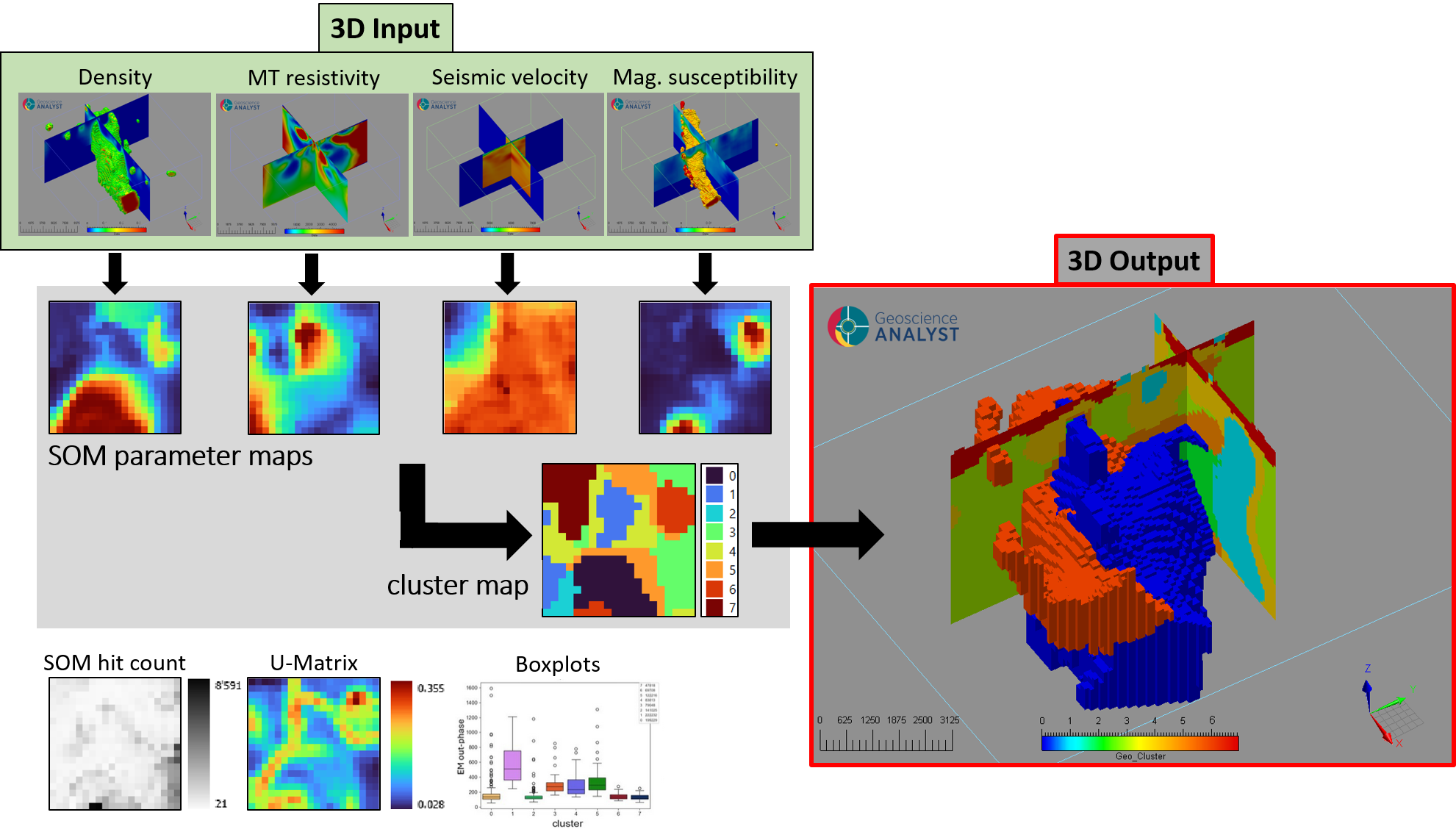Mineral exploration is no longer limited to surface observations or 2D maps. Today, the subsurface tells the real story—and advangeo® 3D Prediction Software is designed to unlock it.
What Does advangeo® 3D Prediction Do?
At its core, advangeo® applies Self-Organizing Maps (SOM)—a powerful machine learning method—to 3D volumetric data. 3D data derived from geophysical measurements typically includes physical parameters of the subsurface, such as:
- Magnetic susceptibility
- Density
- Electrical conductivity
- Other geophysical measurements
Instead of analyzing each parameter separately, SOM brings them together. It identifies clusters in 3D space, where each cluster represents a unique combination of physical properties. These clusters often correspond to geological structures or conditions favorable for mineralization. By analyzing these clusters with their parameters in three dimensions, the software identifies patterns and relationships that are invisible to traditional methods.

Figure 1: Workflow of SOM-based 3D mineral predictive mapping using advangeo® 3D Prediction software. Multiple geophysical models (density, MT resistivity, seismic velocity, magnetic susceptibility) are combined as input. SOM generates maps for each parameter and a cluster map from those. The clusters can be evaluated and analyzed using hit count, U-Matrix, boxplots, and the parameter maps. The resulting clusters are mapped back to 3D geo space and can be visualized as a 3D prediction model for exploration targeting.
What Is SOM and Why Does It Matter?
Self-Organizing Maps (SOM) are a type of unsupervised neural network that organizes complex, multi-dimensional data into clusters based on similarity. In mineral exploration, this means SOM can:
- Detect subtle patterns across multiple geophysical parameters.
- Group similar subsurface conditions into clusters.
- Provide a clear, visual representation of these clusters in 3D.
This approach is particularly useful for integrating anomalies from different geophysical models, revealing hidden relationships that traditional methods might miss.
Why Is This Powerful?
Mineral deposits rarely reveal themselves through a single anomaly. They are usually associated with a pattern of anomalies across multiple geophysical models. SOM excels at detecting these patterns by grouping similar data points into clusters, each characterized by its physical parameters.
Once these clusters are defined, geologists can:
- Interpret their geological meaning
- Link them to known mineralization models
- Prioritize exploration targets based on predictive potential
Benefits for Mineral Predictive Mapping
- Integrated Analysis: Combines multiple geophysical datasets into one coherent interpretation.
- 3D Analysis: Unlike conventional 2D mapping, advangeo® 3D works with full volumetric models, giving a more realistic view of the subsurface.
- Data-Driven Targeting: Reduces guesswork and focuses on areas with the highest mineral potential.
- Cost Efficiency: Minimizes unnecessary drilling and accelerates decision-making.
- Scalable: Handles large datasets from airborne surveys, ground measurements, and borehole logs.
- User-Friendly Visualization: Outputs intuitive 3D models that geologists and decision-makers can easily interpret.
The Big Picture
As demand for critical raw materials grows, exploration must become smarter and more sustainable. advangeo® 3D Prediction Software delivers exactly that—using machine learning to transform complex geophysical data into actionable insights for mineral predictive mapping and to reveals hidden opportunities beneath the surface.
Author
Ina Storch
Graduated Geophysicist (MSc., PhD)
Beak Consultants GmbH
